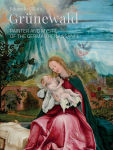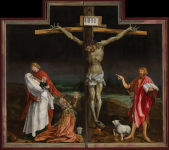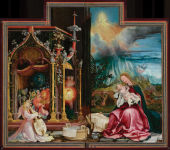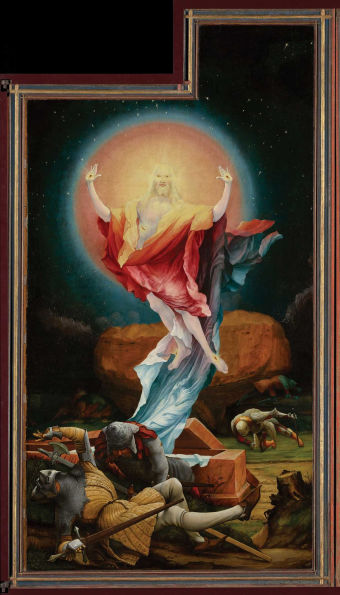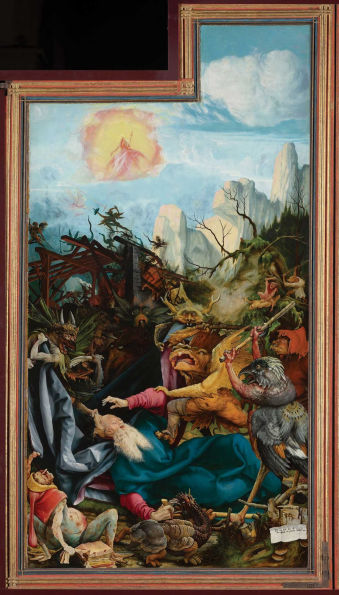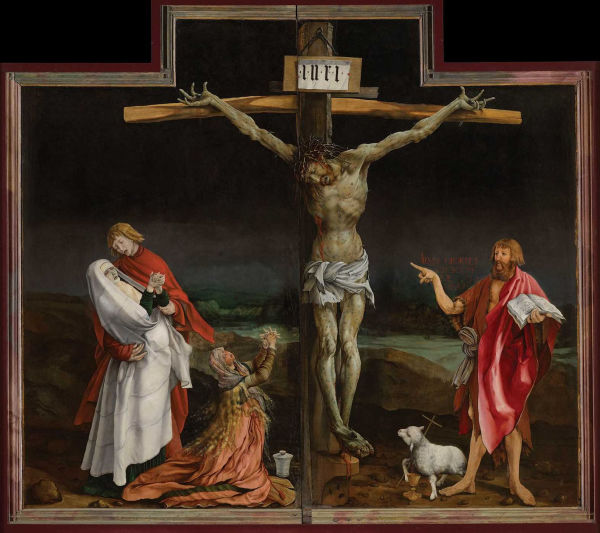Grünewald: Painter and Mystic of the German Renaissance
An important monograph dedicated to one of the most important protagonists of German Renaissance painting, Mathis Grünewald (c. 1480-1528), in the light of significant archival and iconographic novelties.
The German painter Matthias Grünewald (c. 1480–1528) has remained one of the most enigmatic figures of the Renaissance, his artistic identity defined by stylistic complexity and historical obscurity. In this study, Edoardo Villata re-examines Grünewald’s oeuvre through a critical reassessment of sources, stylistic developments, and the broader network of artistic influences. Moving beyond established interpretations, Villata explores the relationship between documentary research and comparative analysis, situating Grünewald within the artistic and intellectual landscape of his time. By integrating stylistic analysis, documentary research, and an expansive perspective that extends beyond painting to sculpture and religious thought (two of the most relevant results are the discovery of the role of the sculptor Tilman Riemenschneider for his training and of Johann von Staupitz, Luther's mentor, for the iconography of the Isenheim Altarpiece), Villata reassesses Grünewald’s possible connections to contemporary artistic centers, offering a new reading of his production and its historical significance. Much more than a monograph, this study challenges prevailing narratives and highlights the necessity of methodological stringency in art historical research. Essential reading for scholars and specialists, it provides an indispensable contribution to Grünewald studies and Renaissance historiography.
1147194027
The German painter Matthias Grünewald (c. 1480–1528) has remained one of the most enigmatic figures of the Renaissance, his artistic identity defined by stylistic complexity and historical obscurity. In this study, Edoardo Villata re-examines Grünewald’s oeuvre through a critical reassessment of sources, stylistic developments, and the broader network of artistic influences. Moving beyond established interpretations, Villata explores the relationship between documentary research and comparative analysis, situating Grünewald within the artistic and intellectual landscape of his time. By integrating stylistic analysis, documentary research, and an expansive perspective that extends beyond painting to sculpture and religious thought (two of the most relevant results are the discovery of the role of the sculptor Tilman Riemenschneider for his training and of Johann von Staupitz, Luther's mentor, for the iconography of the Isenheim Altarpiece), Villata reassesses Grünewald’s possible connections to contemporary artistic centers, offering a new reading of his production and its historical significance. Much more than a monograph, this study challenges prevailing narratives and highlights the necessity of methodological stringency in art historical research. Essential reading for scholars and specialists, it provides an indispensable contribution to Grünewald studies and Renaissance historiography.
Grünewald: Painter and Mystic of the German Renaissance
An important monograph dedicated to one of the most important protagonists of German Renaissance painting, Mathis Grünewald (c. 1480-1528), in the light of significant archival and iconographic novelties.
The German painter Matthias Grünewald (c. 1480–1528) has remained one of the most enigmatic figures of the Renaissance, his artistic identity defined by stylistic complexity and historical obscurity. In this study, Edoardo Villata re-examines Grünewald’s oeuvre through a critical reassessment of sources, stylistic developments, and the broader network of artistic influences. Moving beyond established interpretations, Villata explores the relationship between documentary research and comparative analysis, situating Grünewald within the artistic and intellectual landscape of his time. By integrating stylistic analysis, documentary research, and an expansive perspective that extends beyond painting to sculpture and religious thought (two of the most relevant results are the discovery of the role of the sculptor Tilman Riemenschneider for his training and of Johann von Staupitz, Luther's mentor, for the iconography of the Isenheim Altarpiece), Villata reassesses Grünewald’s possible connections to contemporary artistic centers, offering a new reading of his production and its historical significance. Much more than a monograph, this study challenges prevailing narratives and highlights the necessity of methodological stringency in art historical research. Essential reading for scholars and specialists, it provides an indispensable contribution to Grünewald studies and Renaissance historiography.
The German painter Matthias Grünewald (c. 1480–1528) has remained one of the most enigmatic figures of the Renaissance, his artistic identity defined by stylistic complexity and historical obscurity. In this study, Edoardo Villata re-examines Grünewald’s oeuvre through a critical reassessment of sources, stylistic developments, and the broader network of artistic influences. Moving beyond established interpretations, Villata explores the relationship between documentary research and comparative analysis, situating Grünewald within the artistic and intellectual landscape of his time. By integrating stylistic analysis, documentary research, and an expansive perspective that extends beyond painting to sculpture and religious thought (two of the most relevant results are the discovery of the role of the sculptor Tilman Riemenschneider for his training and of Johann von Staupitz, Luther's mentor, for the iconography of the Isenheim Altarpiece), Villata reassesses Grünewald’s possible connections to contemporary artistic centers, offering a new reading of his production and its historical significance. Much more than a monograph, this study challenges prevailing narratives and highlights the necessity of methodological stringency in art historical research. Essential reading for scholars and specialists, it provides an indispensable contribution to Grünewald studies and Renaissance historiography.
55.0
Pre Order
5
1

Grünewald: Painter and Mystic of the German Renaissance
304
Grünewald: Painter and Mystic of the German Renaissance
304Paperback
$55.00
55.0
Pre Order

Product Details
| ISBN-13: | 9788833673349 |
|---|---|
| Publisher: | Officina Libraria |
| Publication date: | 12/23/2025 |
| Series: | La Grande Officina |
| Pages: | 304 |
| Product dimensions: | 7.87(w) x 10.63(h) x (d) |
About the Author
From the B&N Reads Blog
